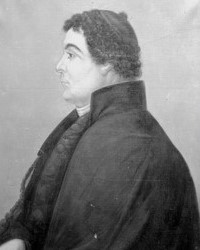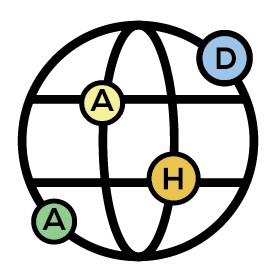An exercise of mapping and digital visualization of travel narratives: The Diario del viaje de Montevideo a Paysandú by Dámaso Larrañaga, 1815
DOI:
https://doi.org/10.24215/27187470e046Keywords:
visualization, mapping, georeferencing, travel narratives, priestAbstract
This article presents a visualization exercise based on the Diario del viaje de Montevideo a Paysandú, a source written by the Priest Dámaso Antonio Larrañaga in 1815. It constitutes a general observation of the priest´s diary through a tool designed for visualizing stories in digital format, StoryMapJS. The organizing principle is based on a selection of geographical locations that were particularly significant to the way in which Larrañaga represents the spaces and places that he visited in his travel both in physical, natural or cultural terms. This is a first approach to this source that is part of a broader work on the study of space in the Río de la Plata at the beginning of the 19th century and the role of ecclesiastical agents in territorial configurations.
Downloads
References
Alexander, N. (2015). On literary geography. Literary Geographies, 1(1), 3-6. https://www.literarygeographies.net/index.php/LitGeogs/article/view/1-2
Barral, M. E. (2016). En el pasado colonial y en el presente revolucionario: los curas párrocos y las parroquias como soportes del cambio político. Mundo Agrario, 17(35), e014. https://www.mundoagrario.unlp.edu.ar/article/view/MAe014
Barral, M. E. (Coord.). (2021). La visita del obispo Lué y Riega. Prohistoria.
Besse, J. M., Clerc, P., Orain, O. y Robic, M-C. (2017). Qu’est-ce que le ‘spatial turn’? En Revue d’histoire des sciences humaines, 30, 207-238.
Cary, J. y Cary G. (1827). Carta Geographica que Comprende los Rios de la Plata, Parana, Uruguay y Grande y Los Terrenos Adyacentes. David Ramsey Map Collection. https://davidrumsey.georeferencer.com/maps/e9501549-eba3-50dc-a6ac-5b920dc05286/
Cantwell, C. y Petersen, K. (2021). Digital Humanities and Religious Studies: A “Why” To Guide. De Gruyter. https://doi.org/10.1515/9783110573022-001
Cerarols, R. y García, A. L. (2017). Geohumanidades. El papel de la cultura creativa en la intersección entre la geografía y las humanidades. Treballs de la Societat Catalana de Geografia, 84, 19-34. https://raco.cat/index.php/TreballsSCGeografia/article/view/98489
Devoto, F. (1986-1991). Espacio e historia. Un recorrido a través de la historiografía francesa contemporánea. Anales de Historia Antigua y Medieval, 24-25, 375-389.
Di Stefano, R. (2010). Colegas clérigos del joven Darwin. Anuario IEHS, 25, 259-280.
Duarte, M., Serra, C. y Venturini, L. (2016). Dámaso Antonio Larrañaga. Naturaleza ilustrada. Montevideo.
Ferrari, A. (2018). Un film de la Patria Vieja. Algunas reflexiones sobre el Diario de Viaje de Montevideo a Paysandú (1815). Monograma. Revista Iberoamericana de Cultura y Pensamiento, 2, 101-122. http://revistamonograma.com/index.php/mngrm/article/view/3
Frega, A. (2016). Prólogo. En Larrañaga, D. A., Diario del viaje de Montevideo a Paysandú (pp. 9-16). UDELAR.
García Gómez, S. (2018). Del papel al mapa. Las posibilidades de la georreferenciación en los Estudios Literarios. Revista De Humanidades Digitales, 2, 120–141. https://doi.org/10.5944/rhd.vol.2.2018.22141
Gelman, J. (1992). Producción campesina y estancias en el Río de la Plata colonial: la región de Colonia a fines del siglo XVIII. Paradigmas de la conquista: historia, historiografía y política. Boletín del Instituto de Historia Argentina y Americana “Dr. Emilio Ravignani”, 6, 41-65.
González Demuro, W. (2013). Presbíteros y ciudadanos. Los clérigos electos para representar a los pueblos orientales en la Asamblea Constituyente. En A. Ribeiro y G. Caetano (Coords.), Las Instrucciones del año XIII: 200 años después (pp. 467-489). Planeta.
Guldi, J. (s.f.). What is the Spatial Turn? Saptial Humanities. https://spatial.scholarslab.org/spatial-turn
Larrañaga, D. (s.f.). Lámina Foja 90. Archivo General de la Nación. Fondo Dámaso Antonio Larrañaga. https://anaforas.fic.edu.uy/jspui/handle/123456789/60004
Larrañaga, D. (1930). Escritos de Don Dámaso Antonio Larrañaga (Parte II). Instituto Histórico y Geográfico del Uruguay. https://anaforas.fic.edu.uy/jspui/handle/123456789/57393
Larrañaga, D. (1965). Selección de Escritos (Vol. 92). Ministerio de Instrucción Pública y Previsión Social.
Leon, S. M. (2008). Slowing down, talking back, and moving forward: Some reflections on digital storytelling in the humanities curriculum. Arts and Humanities in Higher Education, 7(2), 220–223. https://doi.org/10.1177/1474022208088650
Iogna Prat, D. (2016). La invención social de la Iglesia en la Edad Media. Miño y Dávila.
Iogna Prat, D. y Zadora-Rio, E. (2005). Formation et transformations des territoires paroissiaux. Médiévales, 49, 5-10.
Jockers, M. (2013). Macroanalysis: Digital methods & literary History. University of Illinois Press.
Lauwers, M. (2005). Paroisse, paroissiens et territoire. Remarques sur parochia dans les textes latins du Moyen ge. Médiévales, 49, 11-32.
Mazel, F. (2016). L’éveque et le territoire. L’invention médiéval de l’espace (Ve-XIIIe siècle). Éditions du Seuil.
Moretti, F. (2015). Lectura distante. Fondo de Cultura Económica.
Ramos, V. (2020). El primer estudio geológico de las Provincias Unidas del Río de la Plata: Los aportes de Dámaso A. Larrañaga. Revista Facultad de Ciencias Exactas, Físicas y Naturales, 7(1), 53-62.
Torre, A. (2008). Un ‘tournant spatial’ en histoire? Paysages, regards, ressources. Annales. Histoire, Sciences Sociales, 63(5), 1127-1144.
Warf, B. y Arias, S. (eds.). (2008). Introduction: The reinsertion of space into the social sciences and humanities. En The spatial turn: Interdisciplinary perspectives (pp. 1-10). Routledge Taylor & Francis Group.

Downloads
Published
How to Cite
Issue
Section
License
Copyright (c) 2023 Maria Elena Barral, Juan José Santos

This work is licensed under a Creative Commons Attribution-ShareAlike 4.0 International License.
Los autores que publican en esta revista están de acuerdo con los siguientes términos:
- Los artículos publicados en la revista se encuentran disponibles en acceso abierto.
- Los autores conservan los derechos de autor y garantizan a la revista el derecho de ser la primera publicación del trabajo al igual que licenciarlo bajo una Licencia Creative Commons Atribución-CompartirIgual 4.0 Internacional (CC BY-SA 4.0), que permite copiar y redistribuir el material en cualquier medio o formato y remezclar, transformar y construir a partir del material bajo los siguientes términos: debe dar crédito de manera adecuada, brindar un enlace a la licencia, e indicar si se han realizado cambios.
- Los autores pueden depositar el trabajo en un repositorio de preprints, postprints, establecer por separado acuerdos adicionales para la distribución no exclusiva de la versión de la obra publicada en la revista (por ejemplo, situarlo en un repositorio institucional o publicarlo en un libro), con un reconocimiento de su publicación inicial en esta revista.
- Se alienta a los/as autores/as a realizar el depósito de datos en SEDICI, o en cualquier otro repositorio de datos de investigación (como Zenodo, donde la AAHD ha creado un repositorio temático para HUMANIDADES DIGITALES), de manera previa a realizar el envío de la contribución a la revista. De este modo, al remitir el artículo solo se deberá indicar la URL donde se encuentran los datos de investigación.

























